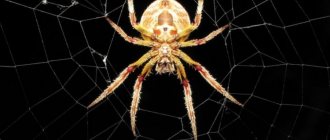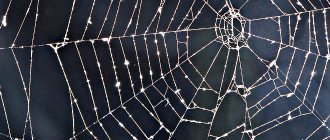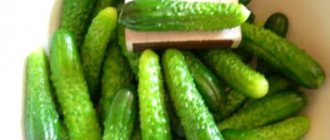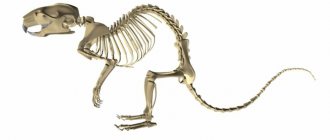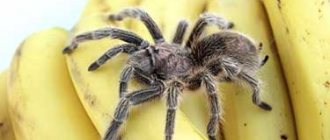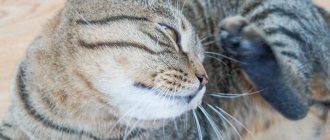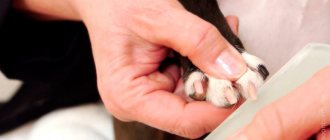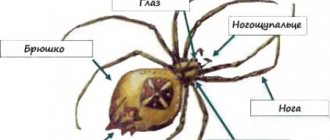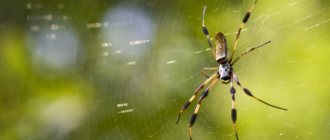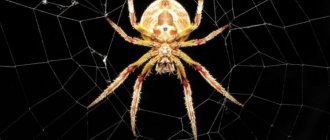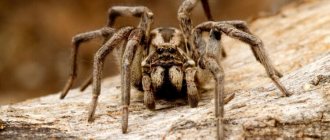We have all observed a situation when a fly, caught in a web, cannot get out of it, desperately twitches and becomes even more entangled in it. Meanwhile, the spider quickly runs towards its victim, not worrying at all about the sticky properties of the web.
How does this happen? Why does a fly stick tightly to the web, but the spider turns out to be invulnerable?
Surprisingly, this question was of interest not only to ordinary people and inquisitive children, but also to scientists. Since the beginning of the last century, they have been struggling with this riddle, and finally solved it.
There are several reasons for this phenomenon:
- not all threads in a web are sticky,
- Spiders have hairs on their legs and a special chemical
- Spiders move in a special way and carefully look after themselves.
Composition of the web
The chemical composition of the web is similar to silk, which is produced by some types of insects, for example, the silkworm. However, the strength of the substance produced by arachnids is much greater than the secretion of caterpillars.
Web
The web consists of two types of substances:
- organic;
- inorganic.
The main thread consists of fibroin. It is a water-insoluble protein consisting of a complex of simple proteins. It is this substance that gives the web its high strength and elasticity. Sericin is a component that provides the web with stickiness. Also on the list of ingredients are hydrogen phosphate and potassium nitrate. They have antiseptic properties and protect the thread from damage by fungi and bacteria.
What does it consist of and where is it formed?
The composition of the web includes the following substances:
- organic compounds - fibroin protein, which makes up the main internal thread, and glycoproteins that form nanofibers located around the main thread. Thanks to fibroin, the web is similar in composition to silk, but much more elastic and stronger;
- inorganic substances - chemical compounds of potassium (hydrogen phosphate and nitrate). Their number is small, but they give the web antiseptic properties and protect it from fungi and bacteria, creating a favorable environment in the spider’s glands for the formation of threads.
In the abdomen of the spider there are arachnoid glands, where a liquid substance is formed that comes out through spinning tubes located on the arachnoid warts. They can be observed at the very bottom of the abdomen.
A viscous liquid comes out of the tube and quickly hardens in air. Using its hind legs, the spider pulls out the thread and uses it for weaving. One spider is capable of producing a thread 0.5 km long. Did you know? Our most common spider, the cross spider, weaves the most famous round trapping web. The spider always weaves a structure of 39 rays, on which there are 35 spiral circles with 1245 fasteners. Cross workers do this work at night and update the network every 1–2 days.
Design features and types of web
Traps created by spiders of different species can differ quite noticeably from each other in their web-weaving technology and appearance. There are several main types of traps:
- Round. The most common. Thickened threads radiate from the center to the sides. They are connected by circles of different diameters, running from the center to the edges. An interesting fact is that the distance between all circles is approximately the same. The spider begins weaving such a web by tensioning the main threads. And then he pulls a thread of smaller thickness, and starting from the outer edge, connects the base with circular lines, the radius of which decreases as it approaches the center. During the hunt, the spider either remains in the center of the trap or sits at the end of the signal thread.
- Zigzag. Some species of arachnids form a zigzag web. This design attracts the attention of potential victims, and in addition, it is much more difficult to get out of it.
- Cone shaped. According to this pattern, traps are weaved by spiders from the funnel-web spider family. Most often, such funnels are located between the stems of plants, and the predator sits at the bottom, waiting for prey. When the prey approaches, the spider pulls it inside the cone.
- Formless. Sometimes there is a web in which it is difficult to detect any symmetrical structure. This is a shapeless jumble of threads. Such webs can often be seen in the corners of residential premises.
- A drop on a string. Mastophora cornigera spiders use uniquely shaped webs to catch insects. This is a small web ball attached to a strong thread. The ball is impregnated with pheromones and is very sticky. The predator lowers the ball on a string, swings it and thus catches prey. For this method of hunting, the spider was named Bolas, by analogy with throwing hunting weapons.
- Between the legs. The peculiarity of this form is not in the weaving of the web, but in its location. Gladiator spiders weave a small web, placing it between their front legs. They cover insects that happen to be nearby with a ready-made trap.
The design of the web will determine exactly how and for how long the spider weaves its web between trees or other supports.
How does a spider weave its web?
The first portion of the released secretion is firmly glued to the selected location. Having thus fixed the beginning of the net being made, the insect gives another call to the system. The threads continue to stretch. How? The viscous substance is pushed through by the hind legs.
Before starting weaving, the spider chooses a place with a comfortable microclimate. It should be dry here, but not sunny. Cool, but not frosty. And, of course, there should be no wind.
When a multi-legged “micro-beast” leaves another location, the threads simply pull out after him (we have already said that they instantly harden in the open air). It moves in such a way that the network is a spiral composition intersected by radii. Where they converge is where the “start” was located. Sizes are usually different. Just like the nature of the spirals. In some places these are not even spirals, but circles of different diameters “inserted into each other.”
But in the forest, spiders build much larger “structures.” Have you noticed how in more often the sought-after “fetters” are stretched across the path? They are attached to tree trunks standing on opposite sides of the pole. Insects achieve this in this way. They produce a very long thread. Under the right circumstances, the breeze picks up the “rope”, mounting it on the branches of the nearest tree. And then it gets more interesting. Having walked to the middle of the “installation” (base) thread, the “multipede” weaves another one. This time hanging freely. Then the cunning man moves to its center, and, hanging vertically down, releases the next one. Until it reaches a nearby support. Using the method shown, a base for the frame is obtained. It's shaped like the letter Y. Now comes the most interesting part. “Tkach” connects the network intersection point with several more radius lines (more sticky). Until you get a lot of spirals. Different webs take different amounts of time - from 30 minutes to 2 hours.
It’s worth knowing that cross makers always have the same design for such a work – a spiral intersected by radii. But for any exotic spiders it can be anything. For example, the inhabitants of the Amazon weave several leaves into their masterpiece, creating decorations that attract flies.
Where does a spider's web come from?
Speaking very generally and figuratively, a spider makes a web the same way as cotton candy is made. In the abdomen of the arthropod, a secretion is collected, which is formed in the internal arachnoid glands. There are 6 types of spider glands that produce threads for various purposes, such as creating a cocoon, for weaving the base of a web, for attaching a web, for covering the base. The set of glands in spiders of different species differs.
Wrapping a web around a victim
In the lower part of the spider's abdomen there are arachnoid warts - movable paired outgrowths, which in some species also serve as organs of touch. The surface of the outgrowths is covered with small hairs. These are arachnoid tubes, each of which is an internal duct of the gland. It is from these tubes that the web comes out. The area where the tubes are located is called the arachnoid field. In addition to the tubes, the web is secreted through chitinous cones, which are also located on the surface of the warts. These cones have a larger diameter and are the ducts of larger glands.
The secretion of the web is controlled by the spider's nervous system, regulating stickiness, thickness, even shade of color.
RIDDLES OF THE WEB
Science and life // Illustrations
The adhesive substance covering the thread of the catching spiral is evenly distributed throughout the web in the form of bead droplets. The picture shows the place where two fragments of the catcher spiral are attached to the radius.
Science and life // Illustrations
Science and life // Illustrations
Science and life // Illustrations
Science and life // Illustrations
The initial stages of building a catching net by a cross spider.
The logarithmic spiral approximately describes the shape of the auxiliary spiral thread that the spider lays when constructing a wheel-shaped catching net.
The Archimedes spiral describes the shape of the adhesive trapping thread.
Zigzag threads are one of the features of the webs of spiders of the genus Argiope.
The crystalline regions of the silk fiber have a folded structure similar to the one shown in the figure. The individual chains are connected by hydrogen bonds.
Young cross spiders that have just emerged from their web cocoon.
Spiders of the family Dinopidae spinosa weave a web between their legs and then throw it over their prey.
The cross spider (Araneus diadematus) is known for its ability to weave large, wheel-shaped trapping webs.
Some types of spiders also attach a long “ladder” to the round trap, which significantly increases the efficiency of hunting.
Science and life // Illustrations
This is what the spider tubes from which the threads of spider silk emerge look like under a microscope.
‹
›
Spiders may not be the most attractive creatures, but their creation, the web, is nothing short of awe-inspiring. Remember how the geometric regularity of the finest threads shimmering in the sun, stretched between the branches of a bush or among tall grass, captivates the eye.
Spiders are one of the oldest inhabitants of our planet, inhabiting land more than 200 million years ago. There are about 35 thousand species of spiders in nature. These eight-legged creatures, which live everywhere, are recognizable always and everywhere, despite differences in color and size. But their most important distinguishing feature is their ability to produce spider silk, a natural fiber unsurpassed in strength.
Spiders use webs for a variety of purposes. They make cocoons for eggs from it, build shelters for wintering, use it as a “safety rope” when jumping, weave intricate trapping nets and wrap up caught prey. A female ready for mating produces a web thread marked with pheromones, thanks to which the male, moving along the thread, easily finds a partner. Young spiders of some species fly away from the parental nest on long threads carried by the wind.
Spiders feed mainly on insects. The hunting devices they use to get food come in a variety of shapes and types. Some spiders simply stretch out several signal threads near their shelter and, as soon as an insect touches the thread, they rush at it from ambush. Others throw a thread with a sticky drop at the end forward, like a kind of lasso. But the pinnacle of spiders’ design activity is still round wheel-shaped nets, located horizontally or vertically.
To build a wheel-shaped catching net, the cross spider, a common inhabitant of our forests and gardens, produces a fairly long, strong thread. A breeze or rising air flow lifts the thread upward, and, if the place for building the web is chosen well, it clings to the nearest branch or other support. The spider crawls along it to secure the end, sometimes laying another thread for strength. Then he releases a freely hanging thread and attaches a third to its middle, so that a Y-shaped structure is obtained - the first three radii out of more than fifty. When the radial threads and frame are ready, the spider returns to the center and begins to lay out a temporary auxiliary spiral - something like “scaffolding”. The auxiliary spiral holds the structure together and serves as a path for the spider when constructing a catching spiral. The entire main frame of the net, including the radii, is made of non-adhesive thread, but for the catcher spiral, a double thread coated with an adhesive substance is used.
What's surprising is that these two spirals have different geometric shapes. The temporary spiral has relatively few turns, and the distance between them increases with each turn. This happens because, when laying it, the spider moves at the same angle to the radii. The shape of the resulting broken line is close to the so-called logarithmic spiral.
The sticky trapping spiral is built according to a different principle. The spider starts at the edge and moves towards the center, keeping the same distance between the turns, creating an Archimedes spiral. At the same time, it bites off the threads of the auxiliary spiral.
Spider silk is produced by special glands located in the back of the spider's abdomen. There are at least seven types of arachnoid glands known to produce different threads, but no known spider species has all seven types at once. Usually a spider has from one to four pairs of these glands. Weaving a web is not a quick task, and it takes about half an hour to build a medium-sized trapping net. To switch to the production of a different type of web (for the catching spiral), the spider needs a minute's respite. Spiders often reuse webs by eating leftover webs that have been damaged by rain, wind, or insects. The web is digested in their body with the help of special enzymes.
The structure of spider silk has been perfectly developed over hundreds of millions of years of evolution. This natural material combines two wonderful properties - strength and elasticity. A web made of cobwebs can stop an insect flying at full speed. The thread from which spiders weave the base of their hunting web is thinner than a human hair, and its specific (that is, calculated per unit mass) tensile strength is higher than that of steel. If you compare spider thread with steel wire of the same diameter, they will support approximately the same weight. But spider silk is six times lighter, which means six times stronger.
Like human hair, sheep wool, and silk from silkworm cocoons, spider webs are composed primarily of proteins. In terms of amino acid composition, the proteins of the spider web - spidroins - are relatively close to fibroins, the proteins that make up the silk produced by silkworm caterpillars. Both contain unusually high amounts of the amino acids alanine (25%) and glycine (about 40%). Areas of protein molecules rich in alanine form crystalline regions densely packed into folds, providing high strength, and those areas where there is more glycine represent a more amorphous material that can stretch well and thereby impart elasticity to the thread.
How is such a thread formed? There is no complete and clear answer to this question yet. The process of web spinning has been studied in most detail using the example of the ampullaid gland of the orb-weaving spider Nephila clavipes. The ampullaid gland, which produces the strongest silk, consists of three main sections: a central sac, a very long curved canal, and a tube with an outlet. From the cells on the inner surface of the sac emerge small spherical droplets containing two types of spidroin protein molecules. This viscous solution flows into the tail of the sac, where other cells secrete another type of protein - glycoproteins. Thanks to glycoproteins, the resulting fiber acquires a liquid crystalline structure. Liquid crystals are remarkable in that, on the one hand, they have a high degree of order, and on the other, they retain fluidity. As the thick mass moves towards the outlet, the long protein molecules are oriented and aligned parallel to each other in the direction of the axis of the forming fiber. In this case, intermolecular hydrogen bonds are formed between them.
Humanity has copied many of nature's design discoveries, but such a complex process as spinning a web has not yet been reproduced. Scientists are now trying to solve this difficult problem using biotechnological techniques. The first step was to isolate the genes responsible for the production of the proteins that make up the web. These genes were introduced into the cells of bacteria and yeast (see Science and Life No. 2, 2001). Canadian geneticists have gone even further - they have bred genetically modified goats whose milk contains dissolved spider web proteins. But the problem is not only in obtaining spider silk protein, it is necessary to simulate the natural spinning process. But scientists have yet to learn this lesson from nature.
The role and significance of the web in the life of a spider
Undoubtedly, spiders primarily need webs to hunt. The woven network contains insects, which constitute the main diet of arachnids. But the web is not only a means of catching prey. In the life of spiders, it performs many different functions:
- Creation of a cocoon. The female weaves strong and comfortable cocoons from the web, in which she lays eggs. After hatching, the little spiders spend the first weeks of their lives in this cocoon, feeling completely protected from the external environment and enemies.
- Shelter. The web allows the arthropod to take shelter from bad weather and hide from enemies.
- Reproduction. Depending on the species, the female or male uses the thread of the web to attract the attention of the opposite sex. Either the male attaches his thread to the female’s network, informing her of his intentions, or the female secretes a thread impregnated with pheromones, by which she can be easily found.
- Vehicle. The strong and elastic structure of the spider web thread makes it an excellent means of transportation. With its help, spiders can move between trees or bushes, and even fly long distances, clinging to a web carried by a gust of wind.
- Protection. Some types of spiders use webs to glue debris together and make a dummy that looks like a spider. In case of danger, they pull the thread, the dummy moves, the predator is distracted, and the spider manages to leave the dangerous place.
Some aquatic species of spiders have air in their web sac, which allows them to stay underwater.
Purpose of the web
You already know how a spider makes its web. But why does she need a topic? For several purposes at once.
- Here the insect takes refuge from any enemy or from bad weather (it entwines a hole with a net).
- From the web, the creature makes nets to catch small flying creatures (flies, etc.).
- Cocoons for protecting eggs (their “cases”) are also made from durable “silk”.
- The web “mat” insures its owner at the moment of a long jump - the spider does not fall.
- The product is used as a container - in it the hunter sometimes drags large prey into a hole.
- A cradle for baby spiders is another purpose for a masterpiece of spinning craftsmanship.
- The cubs, ready for independent life, are sent along “ropes” to different corners.
- The adhesive substance prevents tarantulas from slipping.
- Sperm transfer.
It remains to add: for catching nets, a more sticky composition of the cobweb substance is used. Although not only the described insects, but all arachnids can prepare webs, only spiders secrete so much sticky substance that they can cover an entire small room with it.
Why doesn't the spider stick to its web?
For a successful hunt, the spider must be able to move quickly and unhindered along the woven web. And he succeeds very well. Unlike its victims, the hunter does not stick to the threads and easily moves along them.
Spider's foot
He succeeds due to several factors:
- The spider's legs have many elastic hairs and claws. Moving along the web, the arthropod clings with its claws, pressing the thread to the hairs. When the spider lifts its leg, the claw unclenches and the hairs straighten, pushing away the web.
- The tips of the spider's legs are covered with a special oily substance.
- The predator moves along dry threads, which it specially weaves into a network to facilitate its movement.
Most often, in the center of the web there is a safe area where the spider waits for its victim.
How is a web weaved?
The basis of each spider trap is 3-4 load-bearing threads. This is the strongest part of the web. Radial threads are attached to the base, each end of which is attached to a support in the form of a tree branch, plant leaves, and so on. The spider applies a trapping spiral to the radial threads, which is the stickiest part of the trap. It is precisely this that spiders fall prey to—to prevent the prey from freeing itself, the predator quickly runs to it and injects poison. These substances transform the insides of insects caught in the web into a nutrient mass, which the spiders simply absorb into themselves.
The structure of the web
Composition and properties of the web
Spider web is a protein compound that also contains glycine, alanine and serine. The inner part of the formed threads is represented by hard protein crystals, the size of which does not exceed several nanometers. The crystals are held together by highly elastic protein bonds.
This is interesting! An unusual property of the web is its internal articulation. When hung on a spider's web, any object can be rotated an unlimited number of times without twisting.
The primary threads are intertwined by the spider and become thicker spider fibers. The strength indicators of the web are close to those of nylon, but are much stronger than the secretion of the silkworm. Depending on the purpose for which the web is intended to be used, the spider can produce not only sticky, but also dry thread, the thickness of which varies significantly.
Differences in webs by spider species
Depending on the species, spiders can weave different webs, which are a kind of “calling card” of the arthropod.
Round web
This version of the web looks incredibly beautiful, but is a deadly design. As a rule, a round web is suspended in a vertical position and has part of the adhesive threads, which does not allow the insect to escape from it. Weaving such a network is carried out in a certain sequence. At the first stage, the outer frame is made, after which radial fibers are laid from the central part to the edges. Spiral threads are woven at the very end.
This is interesting! A medium-sized circular web has more than a thousand point connections, and its production requires more than twenty meters of spider silk, which makes the structure not only very light, but also incredibly durable.
Information about the presence of prey in such a trap comes to the “hunter” through specially woven signal threads. The appearance of any breaks in such a web forces the spider to weave a new web. Old webs are usually eaten by arthropods.
Strong web
This type of web is characteristic of nephilous spiders, which are widespread in Southeast Asia. The trapping nets they build often reach a couple of meters in diameter, and their strength allows them to easily support the weight of an adult.
Such spiders catch in their strong web not only ordinary insects, but also some small birds. Research results show that spiders of this type can produce about three hundred meters of spider silk daily.
Web weaving technology
As a rule, many species of spiders prefer to be nocturnal, so they weave webs mainly at night. On average, a spider spends about an hour on this procedure. If you need to repair an insect trap, it takes even less time.
Below you can see in the video how a spider weaves a web and how much time it takes him to do it. If the web is torn off, then the next morning exactly the same web will appear in the same place. The most beautiful webs are produced by orb weavers. Using strong threads, the spider forms a triangle, after which it fills it with cells of a certain size.
Interesting to know! In the tropical forests of Brazil lives a tarantula spider that weaves such a strong web that local fishermen use it as nets to catch fish. From spider threads you can weave not only a thin, but also a fairly strong fabric. Some companies make body armor from spider substances.
In the garden you can see how the spider weaves a web, placing it on 2 trees. This could be an openwork fishing net or a funnel that glitters in the sun, attracting insects. Of course, for many this process is a mystery. It is even difficult to imagine how the spider was able to stretch its web between two trees. As a rule, a spider flies on a web from one tree to another under the influence of the wind. Having secured the second end, the simplest thing he can do is fill the space with cells.
At the same time, while in a state of flight, the spider controls the distance to the neighboring tree, while adjusting the length of the web. Sometimes, in order to catch on to a branch, he simply shoots a web at the right place.
The spider weaves a web. Watch this video on YouTube
What do spiders eat?
This is a fundamentally important question, since a spider weaves a web primarily to obtain food. Note that all species of spiders, without exception, are predators. However, their diet varies greatly depending on their size, hunting methods, and location. All tenet (web-weaving) spiders are insectivorous, and their diet is based primarily on flying forms.
Although if a crawling character falls onto the web from a tree, its owner will not disdain him. Those who live in burrows and closer to the ground eat mainly orthoptera and beetles, although they may drag a small snail or worm into their shelter. Among the diversity of what spiders feed on, there are also larger objects.
For the aquatic representative of the tribe called Argyroneta, crustaceans, aquatic insects and fish fry become victims. Exotic giant tarantulas prey on frogs, birds, small lizards and mice, although most of their diet consists of the same insects. But there are also more fastidious species. Members of the family Mimetidae hunt only spiders that do not belong to their species.
